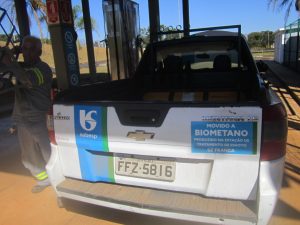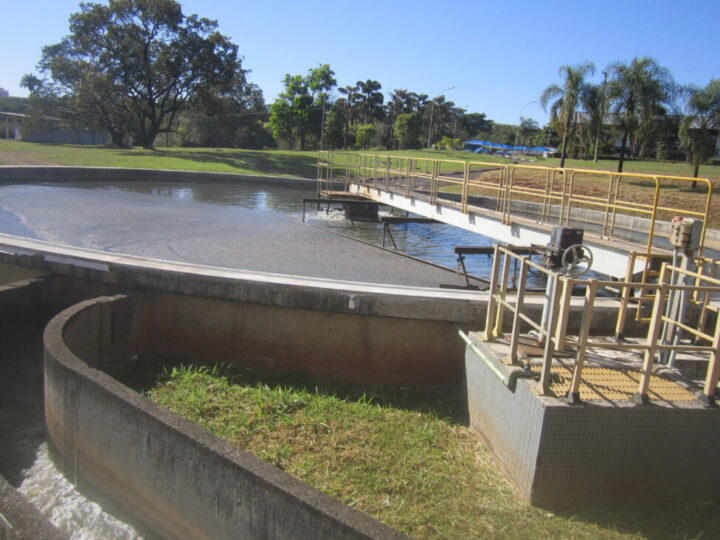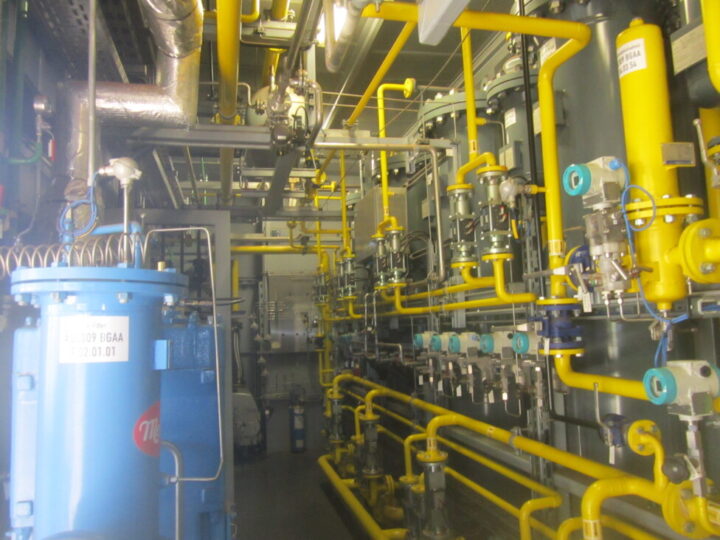
A pickup truck is fueled with biomethane at a pump in the Franca Wastewater Treatment Plant, in the southeastern Brazilian state of São Paulo. Some 40 vehicles are run on biofuel produced from wastewater treatment. The resulting sludge goes through a biodigestion process, which extracts biogas, which is then refined as biomethane. CREDIT: Mario Osava / IPS
By Mario Osava
FRANCA, Brazil, Jul 21 2023 – The city of Franca is an example of basic sanitation in Brazil. In addition to providing universal treated water and sewage to its 352,500 inhabitants, it extracts biogas from wastewater and refines it to fuel its own vehicles.
Biomethane, the final product also called renewable natural gas, replaces fossil fuels and is used in 40 vehicles of the state-owned company Saneamiento Básico do Estado de São Paulo (SABESP) in Franca, in the northeast of the state of São Paulo.”We are a laboratory, a pilot project, which SABESP will replicate in other facilities when the economic and technical feasibility has been proven and the qualification and regulation of biomethane is in place.” — Alex Veronez
SABESP Franca has been producing biogas at its main wastewater treatment plant (ETE) since its inauguration in 1998, but for 20 years it flared the gas in order to avoid pollution. In 2018 it switched to purifying it to initially supply 19 vehicles.
The city became a symbol of good sanitation practices when it reached first place in the ranking of the 100 largest Brazilian municipalities by the non-governmental Instituto Trata Brasil, which monitors the sector and promotes awareness of it.
From 2015 to 2020 Franca remained in the lead, but fell to ninth place in 2023, in the report released in March. Reduced investment, relative to income, was one of the factors leading to the decline. But the city continued to score top marks in nine of the 12 categories evaluated.
The main reason for the decline, according to the institute’s executive president, Luana Pretto, was the rate of water loss in distribution: 28.89 percent. The target is 25 percent. This item is also measured by the losses in each connection, in which the city is doing well, but the evaluation takes into account both indicators.
“The competition is fierce among the top positions,” Pretto told IPS from nearby São Paulo. “The top-ranked improve even more, while those at the bottom get worse. The best ones, with sound systems in place, have more capacity to invest in expansions and improvements. At the bottom, many new investments are required.”

Alex Veronez, district manager of the São Paulo State Basic Sanitation company, is interviewed in his office in the city of Franca in southeastern Brazil. The production of biomethane from sewage here is a “laboratory” to be replicated after proving its economic and technical feasibility, in addition to producing improvements such as drying the sludge to convert it into biofertilizer. CREDIT: Mario Osava / IPS
Biogas complements sanitation
Extracting biogas from wastewater and using biomethane, in which SABESP Franca is a pioneer in Brazil and Latin America, would improve the ranking, since it complements sanitation, she acknowledged. But it is not included in the assessment.
Franca is the only one of Brazil’s 5,575 municipalities that produces biomethane from wastewater, even in the SABESP system, which is responsible for the basic sanitation of 375 municipalities in the southeastern state of São Paulo, with a total of 28 million inhabitants.
“We are a laboratory, a pilot project, which SABESP will replicate in other facilities when the economic and technical feasibility has been proven and the qualification and regulation of biomethane is in place,” explained Alex Veronez, district manager of SABESP in Franca, which is responsible for operations in 16 municipalities.
The biomethane plant was inaugurated in 2018, thanks to a partnership with the German Fraunhofer institute, which provided the refining and storage equipment, while SABESP carried out the necessary works and the adaptation of its vehicles to biofuel.
Investments totaled seven million reais (1.5 million dollars at the current exchange rate) and a return on the investment is expected in seven years.

A decanting pond is the first step in the treatment of wastewater that then goes through other processes until it is sufficiently clean to be returned to the river, at the Wastewater Treatment Plant in Franca, a city in southeastern Brazil. This leaves sludge that goes to the biodigesters where biogas is produced. CREDIT: Mario Osava / IPS
The benefit is primarily environmental. The International Center for Renewable Energy-Biogas (CIBiogás) estimates that biomethane reduces gasoline pollution by 90 percent.
Its production is only the final part of the 550 liters per second wastewater treatment plant, about 85 percent of Franca’s total. It comprises several processes and numerous ponds, for decanting and oxygenation that increase the reproduction of the microorganisms necessary for biogas production in three large biodigesters
Regulations needed for biofertilizer
The sludge that goes through the biodigestion process that extracts gases from it can be converted into fertilizer. As such it was distributed to farmers during the 13 initial years of the ETE, until new regulations on fertilizers by the Ministry of Agriculture and Livestock prevented it from being used.
Since then, the sludge has been discarded in the city’s sanitary landfill, a waste that also has costs for transporting a material that is heavy due to its 80 percent moisture. Composting treatment to eliminate impurities such as fecal coliforms could enable it to be used as biofertilizer, but it became unfeasible due to the cost.
“We spend a lot to carry water to the landfill,” lamented Veronez in a conversation with IPS in his office at SABESP in this southern city.
In order to save money and create better conditions for converting sludge into fertilizer, SABESP Franca is implementing a new drying system, which has been purchased and is being installed, as well as renovating a greenhouse to dry the sludge using solar thermal energy.

The Franca Wastewater Treatment Plant in southeastern Brazil has three large biodigesters that extract biogas from sludge, where the microorganisms that perform biodigestion reproduce, in a process that eventually gives rise to biomethane. CREDIT: Mario Osava / IPS
“This will allow us to dry 90 tons of sludge per day,” the manager said. It will save on transportation costs and represents a step forward towards the regulation and development of compost, an additional product that would be added to biomethane in the use of organic waste.
For now, only light SABESP vehicles use biomethane. Successful tests were carried out on a bus from the Swedish company Scania. Sweden is a country that uses biofuel extensively in its heavy vehicles.
But the sanitation company does not plan to sell biomethane, which it produces for its own use. SABESP has many vehicles and a level of energy consumption that will demand all the biogas and biomethane it produces in the long term, said Veronez, a construction engineer.
There are many challenges standing in the way of fully taking advantage of urban sewage gases, including the organization of the market and regulation of the activity, which is a recent development in Brazil, unlike in Europe.
The biggest progress in producing biogas is in landfills, especially for electricity generation. In a few cases it is converted into biomethane.
The energy potential of sanitation
In Brazil, only about two percent of the potential for biogas is being tapped, the Brazilian Biogas Association (Abiogás) estimates. The main sources are agricultural waste, led by sugar cane residue and animal excrement, landfills and urban wastewater.

Part of the equipment at Franca’s Wastewater Treatment Plant, for processing the biogas that generates biomethane, described as renewable natural gas, which is already replacing fossil fuels in 40 of the company’s vehicles on an experimental basis. CREDIT: Mario Osava / IPS
But the potential of basic sanitation, limited in relation to agriculture and landfills, would increase if the goal of universalizing its services by 2033, set by the regulatory framework for the sector passed by Congress in 2020, is met.
In Brazil, 44.2 percent of the population of 203 million people still has no sewerage service. The goal set by the Sanitation Framework approved by Congress in 2020 is for at least 90 percent of the population to have access to wastewater treatment by 2033.
The goal of universalization of treated wastewater is more feasible because it already stands at more than 85 percent of the total. The problem is droughts, which have become more frequent as a result of climate change.
“Franca was caught off guard by the 2014 drought, a novel experience because we did not know the limits of our water sources, the measurements were insufficient,” Veronez acknowledged.
Water security improved with the June 2022 inauguration of a new water treatment plant that takes water from the Sapucaí-Mirim River, the largest in the region. Until now, the local water supply depended basically on the smaller Canoas River, which cuts across the municipality.
The new catchment will serve 30 percent of the population, but it will be connected to the old system so that it can compensate for eventual reductions in flow from other sources, explained the manager of SABESP Franca.